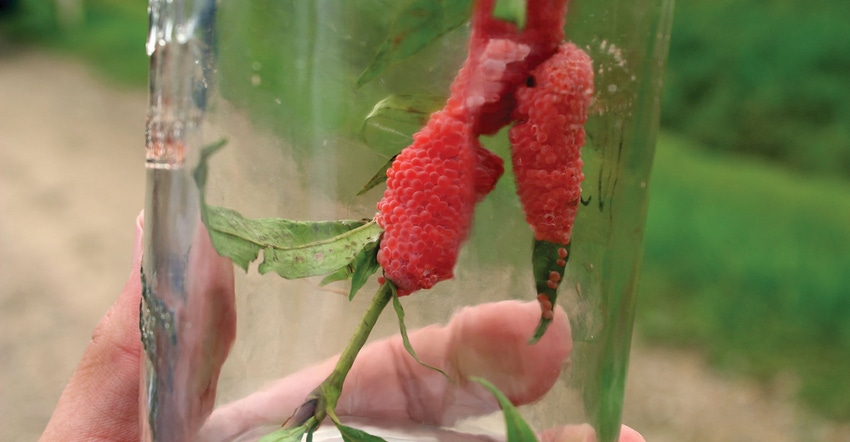
Rice water weevils are the number one pest reducing yields in rice fields across Louisiana and the nation. At the 110th Annual Rice Field Day at the H. Rouse Caffey Rice Research Station, in Crowley, La., Dr. Blake Wilson talked about his latest research with insecticidal seed treatments, which now form the basis for his suggested weevil management strategy.
The small weevils feed on rice leaves, causing longitudinal scars on the leaf tissue. “It’s really the larvae that feed on the roots of the plant which causes the major impact to the crop,” says Wilson. “Their impacts are often difficult to see, and in some cases, infestations develop that are so bad, the rice plants will end up floating on the water’s surface because roots become so severely pruned they are unable to stay in the ground.”
As Wilson held up healthy plants next to a plant exhibiting weevil damage, the differences were obvious. The affected plant showed an impact from reduced nutrient uptake and overall poor plant health. “We have previously identified the most effective seed treatment against weevils as Dermacor,” says Wilson. “It’s used widely by rice farmers across our state for control. Now we’re looking at using multiple combinations of seed treatments, and how control of multiple insect pests can improve yields.”
Previous research has shown that some rice varieties are more tolerant to weevil injury, meaning plants lose less yield under comparable infestations of the weevil. “The hybrid varieties in particular show potential to maintain some yield levels under weevil infestations,” says Wilson. “The tillering ability and robustness of hybrids allow them to grow through the weevil damage.”
Wilson’s graduate student is investigating what mechanisms may be behind the tolerance and allowing yields to be maintained. Cultural practices like planting dates and timing of field flooding have been shown in previous studies to have an effect on yield loses to weevils.
Stink bugs and apple snails
Wilson is also conducting research on rice stink bugs, which feed primarily on headed rice. Current research indicates three stink bugs per 10 sweeps during the first two weeks of heading as the recommended threshold to keep peck or spotty rice below the levels where growers may be penalized at the mill.
“After the first two weeks of heading, that threshold would need to be increased to 10 stink bugs per 10 sweeps as rice becomes less susceptible to peck and stink bug damage as the grain starts to approach the hard dough stage,” says Wilson.
Pyrethroids have generally been recommended to control stink bugs in rice, but recently a new product on the market called Tenchu is offering control. “Tenchu has exhibited longer periods of control through its residual activity,” says Wilson. “This could reduce the need for second or third applications, while also lowering a farmer’s input costs.”
Wilson and his graduate student have also been focusing some of their research on damage from apple snails. They have been found in Louisiana for a number of years but have usually only been found in natural bodies of water like bayous and canals. Recently however, they have started moving into rice habitats and crawfish ponds where they are appearing in increasingly large numbers.
The first signs of apple snails will be their large pink egg masses that resemble wads of pink bubble gum. “These egg masses will appear on pipes, plants or any other structural surfaces,” says Wilson. “This is causing some concern in our grower and research communities because until now, apple snails have only been a rice pest in other parts of the world — particularly Asia and Spain.”
Production practices like drill seeding may limit the impact of the snails, but Wilson noted monitoring them closely is still needed. “Right now, they seem to be infesting crawfish ponds more than rice fields where we’ve seen them competing with the crawfish for forage,” says Wilson. “They will also clog crawfish traps and reduce the efficiency of trapping because producers have the extra step of sorting through the trap captures and separate the snails.”
Chemical strategies are being considered for potential control to reduce the overall impact in rice and crawfish operations where apple snails are starting to reach higher population levels.
About the Author(s)
You May Also Like




